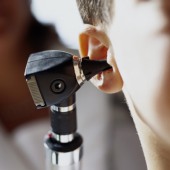
TUESDAY, July 20 (HealthDay News) — Poor children with hearing loss are as likely as other children to receive cochlear implants, but they may experience more complications afterward, a U.S. study has found.
A cochlear implant is a small electronic device that helps provide a sense of sound to deaf people. Recent research suggests that only 55 percent of all U.S. children aged 1 to 6 who are candidates for cochlear implants receive them, according to the authors of the new study in the July issue of the Archives of Otolaryngology — Head and Neck Surgery.
The researchers looked at 133 Ohio children who were referred for cochlear implants between 1996 and 2008, including 64 who were covered by Medicaid and 69 who were privately insured. There were no differences between the two groups in the likelihood of receiving an initial cochlear implant, age at referral to the implant program, or age at implantation.
But the investigators found that children in the Medicaid group were four times more likely to suffer complications than privately insured children (19.6 percent vs. 4.9 percent, respectively) and were also more likely to experience major complications (11.8 percent vs. 3.3 percent, respectively).
The Medicaid-covered children also missed many more follow-up appointments (35 percent vs. 23 percent) and more consecutive visits (1.9 percent vs. 1.1 percent) than those with private insurance, the report indicated.
“Given the excellent Medicaid coverage in Ohio, our results suggest that eliminating the definite financial obstacle that currently exists in other states across the nation for children from lower-income households would allow all eligible children, regardless of socioeconomic background, access to this powerful technology,” study author David T. Chang, of Case Western Reserve University School of Medicine, University Hospitals Case Medical Center, Cleveland, and colleagues said in a news release form the journal’s publisher.
“However, despite equal access among Medicaid-insured and privately insured patients, there seem to be important differences between the groups post-implantation that influence outcome, namely, decreased follow-up compliance, increased incidence of minor and major complications” and decreased rates of implantation of a second device in the other ear, they added.
“Taken together, these results indicate that centers should further investigate opportunities to minimize these downstream disparities,” Chang’s team concluded.
More information
The U.S. National Institute on Deafness and Other Communication Disorders has more about cochlear implants.

